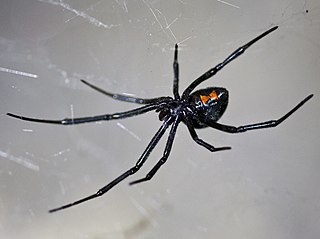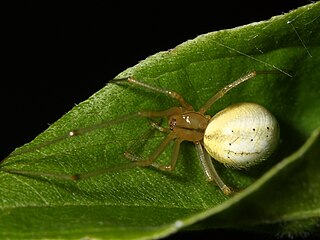
Latrodectus is a broadly distributed genus of spiders with several species that are commonly known as the true widows. This group is composed of those often loosely called black widow spiders, brown widow spiders, and similar spiders. However, the diversity of species is much greater. A member of the family Theridiidae, this genus contains 34 species, which include several North American "black widows". Besides these, North America also has the red widow Latrodectus bishopi and the brown widow Latrodectus geometricus, which, in addition to North America, has a much wider geographic distribution. Elsewhere, others include the European black widow, the Australian redback spider and the closely related New Zealand katipō, several different species in Southern Africa that can be called button spiders, and the South American black-widow spiders. Species vary widely in size. In most cases, the females are dark-coloured and can be readily identified by reddish markings on the central underside (ventral) abdomen, which are often hourglass-shaped.

Theridiidae, also known as the tangle-web spiders, cobweb spiders and comb-footed spiders, is a large family of araneomorph spiders first described by Carl Jakob Sundevall in 1833. This diverse, globally distributed family includes over 3,000 species in 124 genera, and is the most common arthropod found in human dwellings throughout the world.

The Agelenidae are a large family of spiders in the suborder Araneomorphae. Well-known examples include the common "grass spiders" of the genus Agelenopsis. Nearly all Agelenidae are harmless to humans, but the bite of the hobo spider may be medically significant, and some evidence suggests it might cause necrotic lesions, but the matter remains subject to debate. The most widely accepted common name for members of the family is funnel weaver.

Orb-weaver spiders are members of the spider family Araneidae. They are the most common group of builders of spiral wheel-shaped webs often found in gardens, fields, and forests. The English word "orb" can mean "circular", hence the English name of the group. Araneids have eight similar eyes, hairy or spiny legs, and no stridulating organs.

The Japanese spider crab is a species of marine crab that lives in the waters around Japan. It has the largest known leg-span of any arthropod.The Japanese name for this species is taka-ashi-gani,, literally translating to “tall legs crab”. It goes through three main larval stages along with a prezoeal stage to grow to its great size.

Crevice weaver spiders (Filistatidae) comprise cribellate spiders with features that have been regarded as "primitive" for araneomorph spiders. They are weavers of funnel or tube webs. The family contains 18 genera and more than 120 described species worldwide.

Scaffold web spiders or cave cobweb spiders (Nesticidae) are a family of araneomorph spiders closely allied with tangle-web spiders (Theridiidae). Like the Theridiidae, these spiders have a comb of serrated bristles on the hind tarsi that are used to pull silk bands from the spinnerets. Nesticidae contains 16 genera and about 300 species, many of which are associated with caves or overhangs. The genus Nesticus is the type for the family and is found throughout the world. The related Eidmannella has speciated considerably in Texas caves and includes some extremely localized species that are considered threatened. One species, Eidmannella pallida, is found in caves and under overhangs, but also in agricultural fields and other habitats away from such restricted areas. The genus Carpathonesticus is found in central Eurasia.

Microstigmatidae is a small family of spiders with about 25 described species in eight genera. They are small ground-dwelling and free-living spiders that make little use of silk.

Zygiella is a genus of orb-weaver spiders first described by F. O. Pickard-Cambridge in 1902. In 2015, Parazygiella was determined to be a taxonomic synonym of Zygiella, and its species were moved to Zygiella.

Cryptachaea is a genus of spiders in the Theridiidae family.

Parasteatoda is a genus of comb-footed spiders that was first described by Allan Frost Archer in 1946. The name is a combination of the Ancient Greek "para-" (παρά), meaning "near" or "next to", and the theridiid genus Steatoda. The Japanese name for this genus is O-himegumo zoku.

Platnickina is a genus of comb-footed spiders that was first described by A. Ö. Koçak & M. Kemal in 2008.

Bathyphantes is a genus of dwarf spiders that was first described by Anton Menge in 1866.
Allan Frost Archer, was an American arachnologist, entomologist and malacologist. He was the curator of Arachnida at the Alabama Museum of Natural History in University, Alabama. Archer was active in the latter half of the twentieth century, especially between 1940 and 1971, when he described numerous species of arachnids and snails in a number of states in the United States and elsewhere. The World Spider Catalog lists 29 genera of spiders named by Archer, of which 16 are still accepted as of September 2016.
Pickardinella is a monotypic genus of Mexican long-jawed orb-weavers containing the single species, Pickardinella setigera. The species was first described by Frederick Octavius Pickard-Cambridge under the name Leucauge setigera, and was moved to its own genus in 1951. Physically, they resemble members of Opadometa and Leucauge. Males are very small, only growing up to about 2 millimetres (0.079 in) long. A female has never been found.
Arcuphantes is a genus of dwarf spiders that was first described by Ralph Vary Chamberlin & Vaine Wilton Ivie in 1943.

Hentziectypus is a genus of comb-footed spiders that was first described by Allan Frost Archer in 1946. Originally placed with Theridion, it was moved to Achaearanea in 1955, and to its own genus in 2008. These spiders most resemble members of Cryptachaea, but are distinguished by a median apophysis that is broadly attached to the tegulum. Spiders of Parasteatoda have a median apophysis attached to the embolus, while those of Achaearanea have a hooked paracymbium on the pedipalps of males.

Ogulnius is a genus of ray spiders that was first described by Octavius Pickard-Cambridge in 1882.

Wendilgarda is a genus of ray spiders that was first described by Eugen von Keyserling in 1886.
















